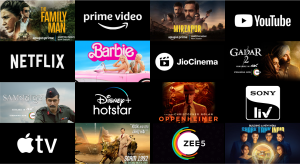- 21 August 2024
- 298
How Streaming Platforms Are Diversifying Content Libraries

Introduction
The digital revolution has transformed the way we consume media, and at the forefront of this transformation are streaming platforms. These platforms have not only changed how we watch television and movies but also how content is curated and delivered to audiences. One of the most significant trends in this evolving landscape is the diversification of streaming content libraries. This article explores the strategies, challenges, and impacts of this diversification.
The Rise of Streaming Platforms

Streaming platforms like Netflix, Amazon Prime Video, Hulu, Disney+, and HBO Max have become household names, providing a vast array of content at the click of a button. The convenience and accessibility offered by these services have led to a decline in traditional cable subscriptions and a surge in on-demand viewing.
The Need for Diversification
As the number of streaming platforms increases, so does the competition for subscribers. To stand out in a crowded market, these platforms are increasingly focusing on diversifying their content libraries. Diversification serves multiple purposes:
- Attracting a Broader Audience: By offering a wide range of content, platforms can appeal to different demographics, including various age groups, cultural backgrounds, and interests.
- Retaining Subscribers: A diverse content library ensures that there is always something new for subscribers to watch, reducing the likelihood of them canceling their subscription.
- Global Reach: As streaming platforms expand their services to international markets, they need to provide content that resonates with local audiences.
Strategies for Diversification

-
Original Content Production
One of the most effective ways streaming platforms have diversified their content libraries is through the production of original content. Netflix, for example, has invested heavily in original programming, producing hit series like “Stranger Things,” “The Crown,” and “Money Heist.” These original shows not only attract new subscribers but also create a unique identity for the platform.
-
Acquiring Diverse Content
In addition to producing original content, streaming platforms are also acquiring a wide range of content from different genres and regions. This includes licensing popular TV shows and movies, as well as lesser-known international films and series. By offering a mix of mainstream and niche content, platforms can cater to a variety of tastes.
-
Collaborations and Partnerships
Collaborations with content creators, production studios, and even other streaming platforms are another way to diversify content libraries. For instance, Disney+ has partnered with Marvel Studios to create exclusive superhero series, while HBO Max has teamed up with DC Comics for original content. These partnerships allow platforms to leverage existing fan bases and introduce new content to their subscribers.
-
Embracing Different Formats
Streaming platforms are also experimenting with different content formats to diversify their libraries. This includes everything from short-form content and documentaries to interactive shows and live events. By offering a variety of formats, platforms can keep their content fresh and engaging.
Challenges in Diversification

While diversifying content libraries offers numerous benefits, it also comes with its own set of challenges.
-
Balancing Quality and Quantity
One of the biggest challenges is maintaining a balance between quality and quantity. While it is important to offer a wide range of content, platforms must ensure that the content is of high quality to keep subscribers engaged.
-
Licensing and Rights Issues
Acquiring content from different regions and genres often involves complex licensing and rights issues. Navigating these legalities can be time-consuming and expensive.
-
Cultural Sensitivity
As platforms expand their content libraries to include international content, they must be mindful of cultural sensitivities. What works in one region may not necessarily work in another, and platforms need to ensure that their content is culturally appropriate and respectful.
-
Technological Challenges
Diversifying content also requires robust technological infrastructure. Platforms need to ensure that their streaming services can handle a wide range of content formats and provide a seamless viewing experience for subscribers.
The Impact of Diversification

-
Enhanced User Experience
A diverse content library enhances the user experience by offering a variety of options to choose from. This not only keeps subscribers engaged but also encourages them to explore new genres and formats.
-
Increased Subscriber Retention
By continually adding new and diverse content, streaming platforms can keep their subscribers engaged and reduce churn rates. Subscribers are less likely to cancel their subscriptions if they feel that there is always something new and interesting to watch.
-
Broader Audience Reach
Diversifying content libraries allows streaming platforms to reach a broader audience. By offering content that appeals to different demographics and cultural backgrounds, platforms can attract subscribers from different regions and increase their global footprint.
-
Competitive Advantage
In a crowded market, a diverse content library can provide a competitive advantage. Platforms that offer a wide range of high-quality content are more likely to stand out and attract new subscribers.
Conclusion
The diversification of streaming content libraries is a trend that is reshaping the media landscape. By offering a wide range of content, streaming platforms can attract a broader audience, retain subscribers, and increase their global reach. While there are challenges to overcome, the benefits of diversification are clear. As the competition among streaming platforms continues to intensify, the importance of a diverse content library cannot be overstated.

